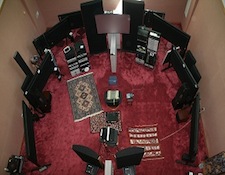It’s the time of year for saving money!
 Last week I was talking with a fellow audiophile about “the old days.” He lamented about how it used to be all about how a component sounded and the ergonomics and reliability were secondary to the sound. I refer to this as “hair shirt audio.”
Last week I was talking with a fellow audiophile about “the old days.” He lamented about how it used to be all about how a component sounded and the ergonomics and reliability were secondary to the sound. I refer to this as “hair shirt audio.”
My phrase harkens back to a simpler time, when persons of strong religious faith called “penitents” would flagellate themselves and wear shirts made of hair over their wounds to increase their discomfort. The modern equivalent is the audiophile who puts together a system that only works some of the time and requires inordinate amount of care and attention to keep it functioning.
Another variation on hair shirt audio would be a system that is so complex that only its owner can operate it. Wives, children, distant relatives are all out of luck if the master of the system isn’t around to get it up and running.
I have, at times in my youth, fallen victim to a component or two that led me down this primrose-lined and very thorny path. But fortunately for me and loved ones in my immediate vicinity, I usually don’t keep gear around that explodes, makes random and loud rude noises, or needs to be readjusted or “tweaked” with all-too-often frequency.
Now don’t misunderstand me, some of the best-sounding systems I’ve ever heard would qualify as hair-shirt systems. Harvey Rosenberg’s extensive set of Quad ESL 57 modifications (some of which I installed on my pair of ESL 57s, back in the day) went from simple mods to baroque endeavors which definitely qualified as hair-shirt.
 I would also classify a room-based Ambisonics system as hair shirt audio, not because it is difficult to use when set up properly, but the number and location of the speakers and necessary baffles makes an Ambisonic install not exactly the ideal set-up for your average multi-use sound-system and family room. If you have a spare room to dedicate totally to Ambisonics, then fine; but for most audiophiles a dedicated and single-purpose system room is not an option. For Audiophiles who are curious and want to hear what Ambisonics can do before going for a full-bore room-based Ambisonic system, there are apps for Android and iDevices that can deliver the Ambisonic sound in a more compact environment.
I would also classify a room-based Ambisonics system as hair shirt audio, not because it is difficult to use when set up properly, but the number and location of the speakers and necessary baffles makes an Ambisonic install not exactly the ideal set-up for your average multi-use sound-system and family room. If you have a spare room to dedicate totally to Ambisonics, then fine; but for most audiophiles a dedicated and single-purpose system room is not an option. For Audiophiles who are curious and want to hear what Ambisonics can do before going for a full-bore room-based Ambisonic system, there are apps for Android and iDevices that can deliver the Ambisonic sound in a more compact environment.
And please don’t confuse hair shirt audio with DIY (do it yourself) audio. DIY can be very tweaky and complex, but it doesn’t have to be. Some of the best DIY components I’ve heard, such as the venerable Dyna Stereo 70 power amplifier kit were basically simple designs. In contrast I’ve seen some extremely tweaky mods of the basic Dyna Stereo 70 were so extensive that they required a second chassis merely for the upgraded power supplies. That is hair shirt.
Just as it would be foolish, anti-social, and just plain dumb to try to dissuade anyone from embracing a particular religion, it would be equally foolish to try to discourage an audiophile from trying increasingly complicated set-ups and modifications. But before you install that next piece of gear that only requires four additional pushes on your remote to get operational, or that new signal chain routing that needs to be disconnected every time you want to use a video source, you might want to think about whether your domestic environment will be a better place after the install; because in the end only audiophiles who are willing participants should be forced to engage in hair shirt audio.





